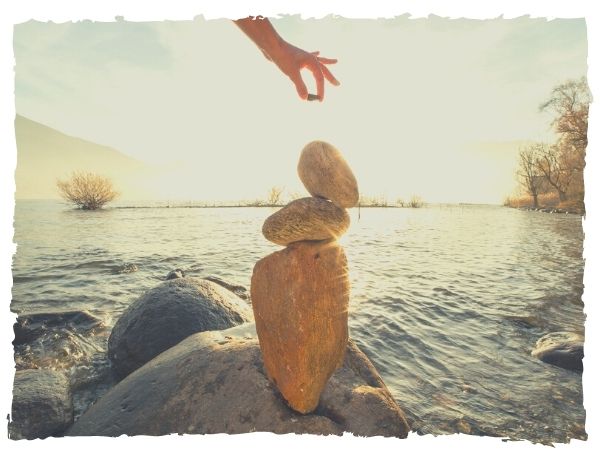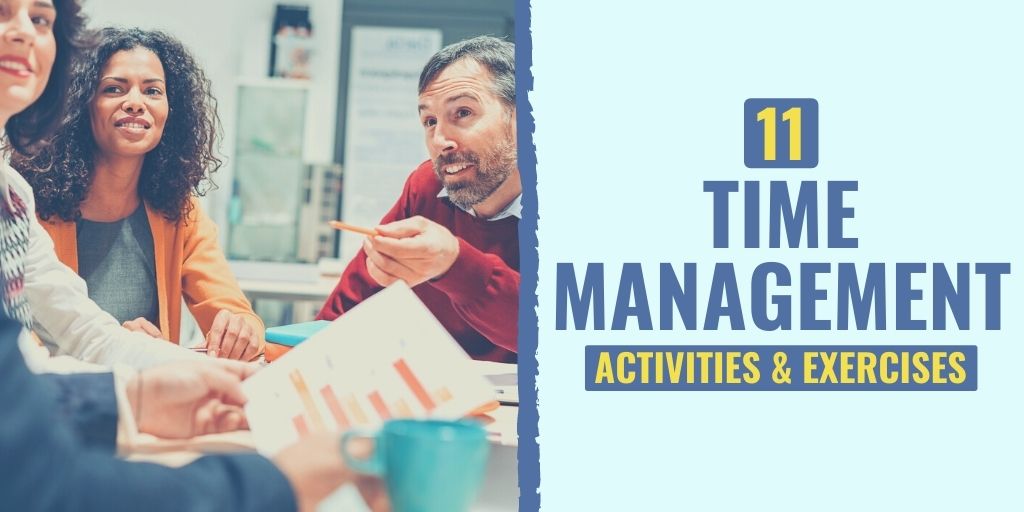There might be affiliate links on this page, which means we get a small commission of anything you buy. As an Amazon Associate we earn from qualifying purchases. Please do your own research before making any online purchase.
What’s one of the big secrets to success?
Successful people are able to juggle their priorities and avoid spending too much time on any one thing–especially if it isn’t an activity that is going to help them get to wherever they’re going. People who celebrate success have a track record of making sure they spend most of their time on the activities and tasks that are most conducive to their happiness, success, and fulfillment.
And, like any other skill, your ability to manage your time effectively may be a work in progress. However, efficient time management can have a marked impact on your personal and professional life.
In this article, we are going to take a look at 11 time management activities and exercises that you can do to enhance your ability to effectively manage your time. After doing these exercises, you may gain a new perspective on your priorities, the time that you have to complete your work, and even the approach you take to getting things done.
But first, let’s take a quick look at what time management is and why it’s important.
What Is Time Management?
Time management is the process of planning and controlling the amount of time you spend on specific tasks, which is a relevant skill when it comes to increasing your efficiency and productivity. However, effective time management is more than just plugging your to-do list into apps and calendars to keep track of your schedule.
Time management is also about:
Knowing how to manage your time is important because it helps you control your schedule and maintain a proper balance in your life. After all, when you have great time management skills, you’ll be able to figure out everything you need to get done each day and how long the tasks will take. From there, you’ll learn how to block out the necessary time for all of your important tasks and spend less time procrastinating or trying to figure out what to do next. Time management skills can help keep you focused on essential tasks.
And, when your time is organized in a way that prevents you from rushing toward a deadline, you can be more intentional about your work and put more effort into it. As long as you keep enough time free to finish all of your projects, you will avoid submitting sloppy or low-quality work. Plus, giving yourself ample time to accomplish your tasks can help reduce stress in your life.
Let’s take a look at 11 time management activities and exercises to help you enhance this important skill.
11 Time Management Activities & Exercises for 2024
1. Piece Together the Big Picture
An important part of time management is knowing the factors that can hinder your working efficiently. One way to do this is to try to complete an activity while purposefully incorporating an impediment to see how it affects your performance.
A fun and simple way for students to complete this exercise is by working on a jigsaw puzzle, which can boost problem solving skills, teach the value of trailing hypotheses, and teach how to adapt and change your perspective when your strategy doesn't go as planned. Research has shown that this fun activity can help students work better in teams and collaborate more effectively.
When putting a jigsaw puzzle together, it’s critical to pay attention to detail, especially if the pieces look similar. Trying to complete a jigsaw puzzle can be an effective time management exercise too.
You can do this time management activity with one student or a large group divided into small teams. Then follow these steps:
This activity can remind students of the value of planning and delegating work, and keeping the long term goal in mind during the process to help with prioritizing smaller objectives. This is an important factor in time management, because without knowing the goal, it’s nearly impossible to know where to start– much less complete an entire project in an orderly and logical way.
2. Your Internal Clock
One noteworthy factor of time management is knowing when you’re the most productive during the day. While many are able to conform to the social 9-5 norm, there are others who are reveling in this pandemic-induced virtual world: the nightowls.
Studies have shown that one’s peak productivity time depends on the following factors:
- Genetics
- Brain structure and patterns of activity
- Chronotype
- The impact of your lifestyle on your habits
- Circadian rhythm
And of course, to maximize your productivity, your sleep schedule should be adjusted accordingly.
The goal of this exercise is to help you learn when you’re the most productive so you can align your internal clock with your daily schedule so you can efficiently manage your time. Follow these steps, either individually or as a group:
This time management activity can help anyone determine when they’re the most productive during the day. After finishing this exercise, it will be easier to effectively create a schedule (e.g., 9/80 work schedule) that focuses on accomplishing the most important tasks during optimal times.
3. Rocks, Pebbles, and Sand Story
Do you remember talking about the story with the rocks, pebbles, and sand? It has come up a few times over the years here at DGH, and it is a great exercise for learning time management.
The metaphor goes like this:
The rocks represent the most significant things in your life–spending time with your family, maintaining your health, etc. The pebbles represent the things that add meaning to your life, but don’t necessarily define you. These things may come and go with time, like jobs, friends, and hobbies. Finally, the sand represents things that may fulfill you in the short term, like watching a movie or scrolling through social media, but don’t add value to your life in the long term.

The lesson to take from this exercise is that if you put sand into the jar first (i.e. you fill all of your time with immediately gratifying tasks such as watching reruns on television), you will run out of room for rocks and pebbles (more meaningful activities). So to manage your time wisely, consider how much time you’re devoting to the rocks or wasting on the sand in your life. With the right balance, you will be able to spend your time in a way that will be beneficial in the long run.
4. The Six of Clubs
This activity demonstrates the important relationship between proper time management and organization. You will need two people and two decks of cards.
To play:
The player with the organized deck will likely find this card right away. Without putting too much thought into it, he or she should be able to flip right to it. The other person, however, will need to glance at each card individually without knowing what card to expect next.
You can compare these decks with 2 schedules. One is properly structured, and the second one is poorly organized. This game can help one understand the importance of time management.
5. How Long Is a Minute?
This is a group exercise that can help participants gauge the accuracy of their perception of time. It is a fun quick activity that offers a reality check for habitual time wasters.
Pick one leader in a group to keep their eyes open while everyone else closes their eyes. The leader sets a timer for one minute and participants are instructed to raise their hand when they think one minute has passed. The leader records how far off each person’s estimate is from the one-minute mark.
The group members probably won’t all raise their hands at the same time. The lesson to be taken away from the exercise is that everyone has a different perception of time, and some activities might take you longer than you originally estimated. So are you using your time efficiently?
6. Commonalities
This activity can help team members get to know each other while also teaching communication skills. Each group member needs a pen and paper to play.
Here’s how:
When the game is over, ask the winner what their strategy was to make the most connections during the allotted time. Their strategies can help relay the importance of efficient and effective communication, which is a big component of time management.
7. Delegation
For this time management activity, players should get into groups of three and determine who is going to be the delegator, the employee, and the observer. The delegator’s job is to think of a task that they don’t enjoy and explain how to do it to the employee. The observer’s job is to write down how well the delegator explained the task. Finally, the employee’s job is to explain the task back after it is explained to them.
Each player should rotate their position so everyone has a chance to play every role. This activity can help people with their time management skills because it can help them practice delegating tasks that may take up a lot of their time.
8. Where Did the Time Go?
All you need for this activity is a pen and paper or a note app on your phone. You can go through the steps on your own and then discuss your results with others who are also aiming to improve their time management skills.
Instructions:
When you think about your 5 accomplishments, you will be able to see the value in the time you spent on each of those tasks. This was all time well spent because you used it to leverage your success in some way. If you don’t take the time to acknowledge your everyday wins (even when they’re small), you may lose momentum or motivation to keep working as hard as you do.
Additionally, recognizing something that was a distraction or “time waster” can help you be more attentive to how you’re spending your time every day. And, once you pair this with something that you wanted to get accomplished but didn’t, it highlights the opportunity cost that the distraction caused you to forego.
You may be surprised at all of the things you’re accomplishing in one day–or you may recognize that you’re wasting too much time on meaningless tasks. Either way, this can help your ability to manage your time in the future.
9. Routine Grid
This group exercise can help you gain a visual perspective of your everyday routine. Each participant should start with 3 blank pieces of paper with 4 rows of 6 squares, making 24 squares on each sheet.
The Activity:
Completing this exercise will give you a visual summary of your day, which can help you organize your time more efficiently. Are there any squares that can be moved around to give you larger gaps of productive time to get into a deep work mode?
10. Group Problem Solving
The goal of this exercise is to work as a group to come up with ways to fight against some common time wasters that are impacting everyone’s productivity. Before starting the game, agree upon three things that are either common distractions in your workplace or processes that are inefficient that could be improved. Get five envelopes and put five blank pieces of paper in each. Write one time waster on the outside of each envelope.
Instructions:
Not only can this exercise help you address various time-wasting factors that people are facing in the workplace, it can also help initiate some dialogue about what strategies could be put into place to work more efficiently.
11. It’s a String Thing
You can do this activity to recognize how much time you can potentially free up to use in more effective ways. You just need 79 inches of string and scissors. The 79 inches represent the average lifespan of 78.99 years of Americans in 2021.
The remaining string represents the time you potentially have left in your life to make a difference in achieving your long term goals and building a legacy that you’re proud of. Life in the future may seem so infinite, but this exercise will show you how limited it actually is and may help you value the time you have more.
Final Thoughts on Time Management Activities and Exercises
Time management is an important skill that can be improved with practice. In this article, we have looked at 11 examples of activities you can do to help practice or recognize the reality of your current time management abilities.
While you may think that you get the point by simply reading these tips, actually following through by doing them can make a stronger impact on how you spend your time in the future. Help yourself make the most out of your day and avoid procrastinating by having fun and trying these exercises.
For more time management tips, check out these 15 time management worksheets for students and adults.

Connie Mathers is a professional editor and freelance writer. She holds a Bachelor's Degree in Marketing and a Master’s Degree in Social Work. When she is not writing, Connie is either spending time with her daughter and two dogs, running, or working at her full-time job as a social worker in Richmond, VA.


